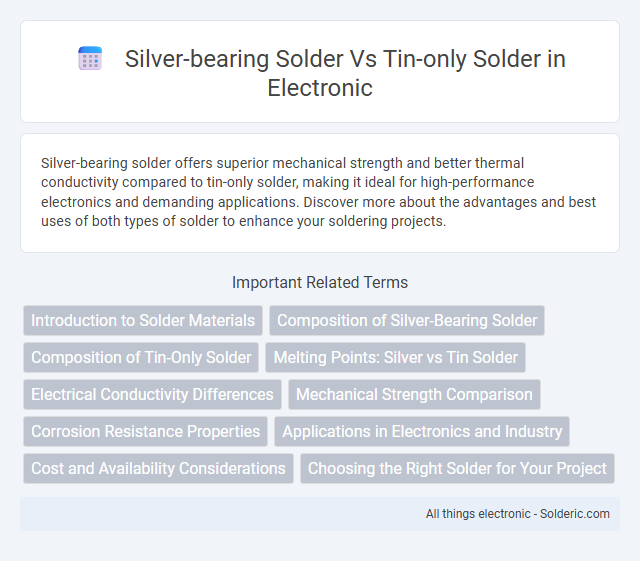Silver-bearing solder offers superior mechanical strength and better thermal conductivity compared to tin-only solder, making it ideal for high-performance electronics and demanding applications. Discover more about the advantages and best uses of both types of solder to enhance your soldering projects.
Comparison Table
| Feature | Silver-bearing Solder | Tin-only Solder |
|---|---|---|
| Composition | Tin with 1-4% Silver | Pure Tin or Tin with minimal additives |
| Melting Point | 217-221degC | 232degC (pure tin) |
| Mechanical Strength | High tensile strength and durability | Lower strength, more brittle |
| Thermal Fatigue Resistance | Better resistance to thermal cycling | Lower resistance, prone to crack under stress |
| Wetting and Flow | Excellent wetting on copper and other metals | Good wetting but may require flux adjustments |
| Cost | Higher due to silver content | Lower, cost-effective |
| Applications | High-reliability electronics, aerospace, automotive | General electronics, consumer devices |
Introduction to Solder Materials
Silver-bearing solder offers superior mechanical strength and enhanced thermal conductivity compared to tin-only solder, making it ideal for high-reliability electronic connections in aerospace and automotive industries. The presence of silver increases the melting point and improves wetting properties, resulting in stronger, more durable joints that resist thermal fatigue and corrosion. Tin-only solder, primarily comprising tin and lead or tin and other metals, provides cost-effective and easy-to-use solutions for general-purpose soldering but lacks the high-performance characteristics required for demanding applications.
Composition of Silver-Bearing Solder
Silver-bearing solder typically consists of a tin-based alloy with 1% to 5% silver content, enhancing its mechanical strength and thermal conductivity compared to tin-only solder. The remaining composition primarily includes tin, sometimes alloyed with small amounts of copper or bismuth to optimize melting temperature and flow characteristics. This specific silver content improves the joint's durability and resistance to thermal fatigue in electronics and plumbing applications.
Composition of Tin-Only Solder
Tin-only solder primarily consists of nearly pure tin, typically with a purity level above 99%, which provides excellent wettability and good electrical conductivity for general electronic applications. Unlike silver-bearing solder, it lacks silver or other alloying metals, resulting in a lower melting point around 232degC and reduced mechanical strength but improved cost efficiency. Your choice depends on balancing the need for strong, durable joints with budget considerations and specific performance requirements.
Melting Points: Silver vs Tin Solder
Silver-bearing solder typically has a higher melting point, around 217-221degC, compared to tin-only solder, which melts at approximately 183degC. The increased melting temperature of silver solder enhances joint strength and heat resistance in electronics and metalwork applications. Tin-only solder melts lower and offers ease of use but may result in less durable connections under thermal stress.
Electrical Conductivity Differences
Silver-bearing solder exhibits higher electrical conductivity compared to tin-only solder due to the presence of silver, which enhances electron flow in the alloy. Tin-only solder typically has lower conductivity, making silver-bearing solder preferable for applications demanding minimal electrical resistance. The improved conductivity of silver-bearing solder supports better performance in high-frequency and sensitive electronic circuits.
Mechanical Strength Comparison
Silver-bearing solder offers superior mechanical strength compared to tin-only solder due to the presence of silver, which enhances tensile and shear strength, especially in high-stress applications. The silver content improves the solder joint's resistance to thermal fatigue and mechanical fatigue, providing greater durability under cyclic loading conditions. In contrast, tin-only solder generally exhibits lower mechanical strength and is more prone to brittle fracture under mechanical stress.
Corrosion Resistance Properties
Silver-bearing solder exhibits superior corrosion resistance compared to tin-only solder due to the presence of silver, which enhances its ability to withstand oxidation and environmental degradation. This solder type maintains joint integrity longer in harsh conditions, reducing the risk of failure in electronic and plumbing applications. Your choice of silver-bearing solder can improve durability and reliability where corrosion resistance is critical.
Applications in Electronics and Industry
Silver-bearing solder offers superior thermal and electrical conductivity, making it ideal for high-reliability electronic connections in aerospace, medical devices, and telecommunications. Tin-only solder, commonly used in consumer electronics and automotive assembly, provides cost-effective and efficient soldering for large-scale production with moderate performance requirements. Industrial applications favor silver-bearing solder where enhanced mechanical strength and corrosion resistance are critical under extreme operating conditions.
Cost and Availability Considerations
Silver-bearing solder generally incurs higher costs due to the premium price of silver and limited suppliers, making it less accessible in bulk compared to tin-only solder. Tin-only solder offers widespread availability with lower prices, benefiting from abundant tin resources and established manufacturing channels. Budget-sensitive projects often favor tin-only solder for cost efficiency and ease of procurement despite silver-bearing solder's superior mechanical and thermal properties.
Choosing the Right Solder for Your Project
Silver-bearing solder offers superior mechanical strength and excellent thermal conductivity, making it ideal for high-stress or high-temperature applications, while tin-only solder is generally more cost-effective and sufficient for standard electronic and electrical connections. The choice depends on the project's specific requirements, including the operating environment, joint durability, and thermal performance. Selecting the right solder ensures optimal reliability and longevity for your electronic assemblies.
Silver-bearing solder vs tin-only solder Infographic

 solderic.com
solderic.com